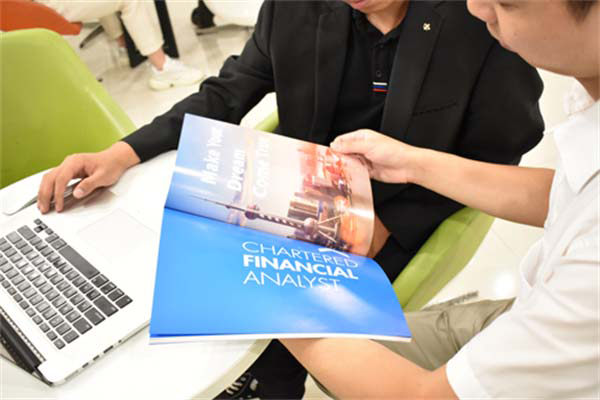》》推荐阅读:
了解2023,
CFA知识点(必考点)Non-Recurring Items
一、Held-to-maturity Security,Trading securities和Available-for-sale securities
公司在财报中将投资分为三类报告:持有至到期投资,交易证券,可供出售金融资产。
Held-to-maturity Security(持有至到期投资):
A held-to-maturity security is purchased with the intention of holding the investment to maturity.
》》》》》》【新】2023年CFA备考资料精华大礼包,限量免费领取
持有至到期投资:
指企业有明确意图并有能力持有至到期,到期日固定、回收金额固定或可确定的非衍生金融资产。
财报中的记录:
这类证券在财务报表中以摊销成本来报告,摊销成本等于原始的发行价格减去本金的偿还,加上折价的摊销或是减去溢价的摊销,再减去减值损失,连续市场价格的改变可以忽略。并且一般是以有特定到期日的债券形式,不像交易型证券,暂时的价格改变不会再财报中体现,已经实现的收益或损失在利润表中报告。
注:股票不能被分类到持有至到期的投资,因为股票没有到期日。
Trading securities(交易证券):
Securities held by a company with the intent to trade them.Also called held-for-trading securities.
交易型证券:
以期在近期内交易中获利而购买的债券和证券。
财报中的记录:
在资产负债表中以公允价值报告,未实现(在证券出售前市场价值的改变)的收益或者损失在利润表中确认,如有衍生投资,则处理方法与交易证券一致。
Available-for-sale securities(可供出售金融资产)
Debt and equity securities not classified as either held-to-maturity or held-for-trading
securities.The investor is willing to sell but not actively planning to sell.
可供出售金融资产:
持有的目的既不是为了短期内交易也不是预期持有至到期的债券或资产。是投资者有意愿出售却没有积极去出售的资产。
财报中的记录:
和交易型证券一样,可供出售的金融资产在资产负债表上以公允价值报告,但是没有实现的收益或损失不在利润表中体现,而是作为部分所有者权益在其他综合利润表中报告。
三者在财报中的记录如下:
Held-to-maturity Security Trading securities Available-for-sale securities
Reported on B/S Amortized cost Fair value
Fair value
Unrealized G/L not reported reported in income statement reported in equity(OCI)
Realized G/L reported in income statement reported in income statement reported in income statement
例:Purchase a 6%bond at par,for 1000 at the beginning of the year.Interest rate have recently increase and the market value declined to 950.Determine the bond’s effect under each classification of securities:
HTM:
B/S:Financial Asset 1000
I/S:Interest Income 60
Trading:
B/S:Financial Asset 950
I/S:Interest Income 60 and Unrealized Loss 50
AFS
B/S:Financial Asset 950 and OCI(Equity)50
I/S:Interest Income 60
解析:按面值1000元的价格购买了息票率为6%的债券,最近利率增加市场价格下降到950,这个债券在不同分类下的报表下应记录如下:
持有到期资产交易型金融资产可供出售资产
资产负债表资产1000资产950资产950权益50
利润表利息收入60利息收入60未实现损失50利息收入60
二、Product costs和Period costs的划分
Product costs(产品成本):
These costs,known as product costs,are capitalized in the Inventories account on the balance sheet and include:
Purchase cost less trade discounts and rebates.
Conversion costs including labor and overhead
Other costs necessary to bring the inventory to its present location and condition.
By capitalizing inventory cost as an asset,expense recognition is delayed until the inventory is sold and revenue is recognized.
产品成本:
在资产负债表中可以资本化进入存货账户的成本,包括剔除折扣后的购买成本,加工成本(包括劳动力和杂项费用),必要的运输和储藏成本。
这些存货成本都资本化作为一项资产,费用是延迟确认的,只有当存货销售出去且收入得以确认时再确认。
Period costs(期间成本)
Not all inventory costs are capitalized;some costs are expensed in the period incurred.These costs,known as period costs,include:
Abnormal waste of materials,labor,or overhead.
Storage costs(unless required as part of production).
Administrative overhead.
Selling costs.
期间成本:
并不是所有的存货成本都可以资本化,一些成本在发生时就需要立即费用化,这部分成本就是期间成本,包括:
非正常的原材料、劳动力以及杂项费用的损耗,生产中非必要的贮藏成本,销售成本,管理中支出的杂项费用。
例:Diabelli Inc.is a manufacturing company that is operating at normal capacity levels.Which of the following inventory costs is most likely to be recognized as an expense on Diabelli’s financial statements when the inventory is sold?
A)Administrative overhead.
B)Allocation of fixed production overhead.
C)Selling cost.
解析:B is correct.Assuming normal capacity levels,allocation of fixed production overhead is a product cost that is capitalized as part of inventory.Thus,this cost will not be recognized as an expense until the inventory is sold(it becomes part of COGS for that period).Administrative overhead and selling costs are period costs that must be expensed in the period incurred.
分配到固定生产的管理费的成本,是资本化作为存货的一部分,因此,这个成本将在存货销售以后才确认费用的,管理的杂项费和销售成本都属于期间成本,在发生时就要费用化。
三、了解LIFO Reserve与LIFO Liquidation的关系
LIFO Reserve(后进先出法的留存):
The difference between the reported LIFO inventory carrying amount and the inventory amount that would have been reported if the FIFO method had been used.
LIFO Reserve=FIFO Inventory–LIFO Inventory
后进先出法的留存:
指的是当前先进先出法存货的账面价值与后进先出法的账面价值之差。
如果公司使用了后进先出法,美国会计法要求在资产负债表或是财报附注中披露后进先出法的留存总额,这个披露可以为分析师在从后进先出法转到先进先出法时,调整销货成本、期末存货时提供必要的信息。
具体调整为,后进先出法下的存货价值,加上后进先出法的留存就是在先进先出法下报告的存货价值。对于后进先出到先进先出法下销货成本的调整,如果此期间后进先出法的留存上升的话,销货成本的调整要减去上升的部分,如果留存下降的话,销货成本的调整要减去下降的部分。
LIFO Liquidation(后进先出法的清算):
A LIFO liquidation incurs when purchased volume is less sales volume.Or,the decrease in volume or quantity of inventory.In this case,the prices for goods being sold are no longer recent prices.
后进先出法的清算:
当购买量减去销量下降时,或存货量下降的时候,会发生后进先出法的清算,这种时候,商品不再以最近的价格销售。LIFO清算可以减少当期销售成本,增加当期利润,因为管理层只要减少当期采购,就会导致以前年度购买的期初存货被“清算”,从而虚增当期利润。
后进先出法清算发生的原因:
后进先出法(LIFO)的缺点在于容易被用来操纵利润,即使用所谓的“后进先出法清算(LIFO liquidation)”操纵手法。简单地说,有可能是管理层的蓄意操控,比如,经济衰退时期顾客的需求下降,公司一般会选择减库存而不是购新货,分析师应该认识到管理层是有机会通过后进先出法清算来操纵并虚增利润的,但这种高利润是不可持续的,因此财务报表中要求披露后进先出法的留存是可以判断是否有清算的发生,下降的后进先出法留存暗示着清算的发生。
例:Assume U.S.GAAP(generally accepted accounting principles)applies unless otherwise noted.A company uses the LIFO inventory method,but most of the other companies in the same industry use FIFO.Which of the following best describes one of the adjustments that would be made to the company’s financial statements to compare it with other companies in the industry?The amount reported for the company’s ending inventory should be:
A.increased by the ending balance in its LIFO reserve.
B.decreased by the ending balance in its LIFO reserve.
C.increased by the change in its LIFO reserve for that period.
解析:A is correct;LIFO Reserve=FIFO Inventory–LIFO Inventory,Adding the ending balance in the LIFO reserve to the LIFO inventory would equal the ending balance for inventory on a FIFO basis.
根据后进先出留存的等式可以算出。
四、Conservative accounting和aggressive accounting的具体比较
Conservative Accounting(稳健的会计原则):
Conservative accounting uses methods that are more likely to understate,rather than overstate,financial performance.In most cases,managers and investors want their businesses to be conservative in their accounting practices.This is because conservative accounting is more likely to undervalue investments rather than overvalue them,leading to management that is more likely to carefully manage risks and exceed expectations.A business that plans conservatively for growth essentially builds in considerable room for error.
稳健的会计原则:
使用的会计方法倾向于低估而不是高估财务表现。大部分情况下,管理层和投资者都希望是稳健的会计准则应用在公司财报中,因为稳健的会计准则倾向于低估运营表现,导致管理层更为仔细地管理风险,因此一般会比预期的表现的好,一个谨慎的商业计划在考虑增长时会将风险因素考虑在内。
Aggressive Accounting(激进的会计原则):
Aggressive accounting,by contrast,might employ more creative techniques that result in overstated financial performance.Unfortunately,many companies are often pressured to do this so they can present the company's performance in the best light for investors and analysts.Nonetheless,aggressive accounting exposes investors and managers to more risk because they are less likely to manage carefully for risks if they're more comfortable with their performance.In addition,aggressive accounting is more likely to result in restatements of performance,which can diminish the credibility of a company's management
激进的会计原则:
使用一些创造性的方法导致高估财务报表的表现。不幸的是,很多公司会迫于压力去选择激进的方法由此给投资者和分析师呈现出******的一面,但是,这样管理层也不会特别仔细的控制风险因此给投资者带来了更大的风险,激进的会计原则有可能导致财务表现的重新评估或调整,因此会减少管理层的公信力。
两者在会计处理上的对比:
激进的保守的
当前的期间成本资本化当前的期间成本费用化
评估可折旧的资产以更长的折旧期限评估可折旧的资产以更短的折旧期限
过高的评估了残值更低的评估残值
直线折旧法加速折旧法
延迟确认发生的损失损失发生时及时确认
更少的应记或坏账费用备抵更多的应记或坏账费用备抵
在递延所得税资产上的价值备抵较小在递延所得税资产上的价值备抵较大
例:In general,firms making aggressive accounting decisions will report book values that are:
A.higher.
B.consistent with fair market value.
C.Lower.
解析:In general,firms making aggressive(conservative)accounting decisions will report higher(lower)book values and lower(higher)future earnings.
激进的会计方法会使公司的账面价值过高,从而高估公司的表现。
五、Sales-type lease和direct financing lease的区别
从出租人的角度,在美国会计法(U.S.GAAP)下,资本租赁可以分为销售型租赁或是直接融资租赁,如果租赁费的当前价值超过了资产的账面价值,这个租赁就是销售型的租赁;如果租赁费的当前价值等于资产的账面价值,这个租赁就是直接融资租赁;
在国际会计法(IFRS)下,不区分销售租赁和融资租赁。但如果出租人为租赁资产的生产者或制造商,租赁费和销售型租赁类似的会计方法在IFRS下也是被允许的。
Sales-type lease(销售型租赁):
A sales-type lease receives the same accounting treatment of a direct-financing lease except the profit of the sale is recognized at inception of the lease as well as the interest income received over the lease term.The lessor records a gross profit from the lease equivalent to the present value of the lease payments less the cost of the asset.
销售类型的租赁:
销售类型的租赁的出租人一般是生产商或者交易者,因为出租的租赁的成本一般小于它的公允价值。
资产负债表的计量:
在租赁开始时,出租人根据租赁支付的现值作为销售收入,资产的当前价值就是成本,两者之差作为利润。
现金流量表上的计量:
租金收入中的利息部分作为运营现金的流入,本金部分作为投资现金的流入。
Direct financing lease(直接融资租赁):
A direct-financing lease combines a sale and financing transaction.The lessor records a sale on its books,removing the asset from its books and replacing it with a receivable from the lease.During the lease term,the lessor receives interest income,calculated by taking the internal rate of return of the asset.The cash inflow equals the lease payments and the cash outflow is equal to the book value of the asset.
直接融资租赁:
租赁费的现值等于租赁资产现值的一种租赁类型。
资产负债表的计量:
租赁的开始,资产从资产负债表中移走,增加了租赁应收账款,当收到租赁费时,每一期支付的本金部分从应收账款中减去。出租人在租赁的开始时不确认利润。
利润表的计量:
每一期租赁费的利息部分等于每一期期初的租赁应收款乘以利率。
现金流量表中:
租赁费当中利息部分的收入记为运营现金流,本金的部分记为投资现金流。
两者的对比:
报表销售类型的租赁直接融资租赁
利润表的开始毛利润=销售收入-销货成本
销售收入=租赁费的现值
销货成本=资产的成本-残值的现值不确认毛利
资产负债表中的初始计量租赁应收款=所有租赁费的现值+清算价值的现值租赁应收款=资产的成本
利润表的期间计量利息收入(期初的租赁应收款×市场利率)
现金流量表的初始计量没有影响
现金流量表的期间计量运营现金流:现金流入
投资现金流:现金流入
例:In a sales-type lease,a lessor recognizes a gross profit at the inception of the lease equaling the:
A.sale price of the leased asset plus the present value of the minimum lease payments.
B.sale price of the leased asset less the present value of the minimum lease payments.
C.present value of the minimum lease payments less the cost of the leased asset.
解析:C is correct,In a sales-type lease,the implicit interest rate is such that the present value of MLP is the selling price of the asset.At the time of the lease inception,the lessor will recognize a gain equaling the present value of the MLPs,less the cost of the leased asset.
销售型租赁在租赁初始计量时,出租人将会把租赁最小支付额的现值减去租赁资产的成本确认为收益。




